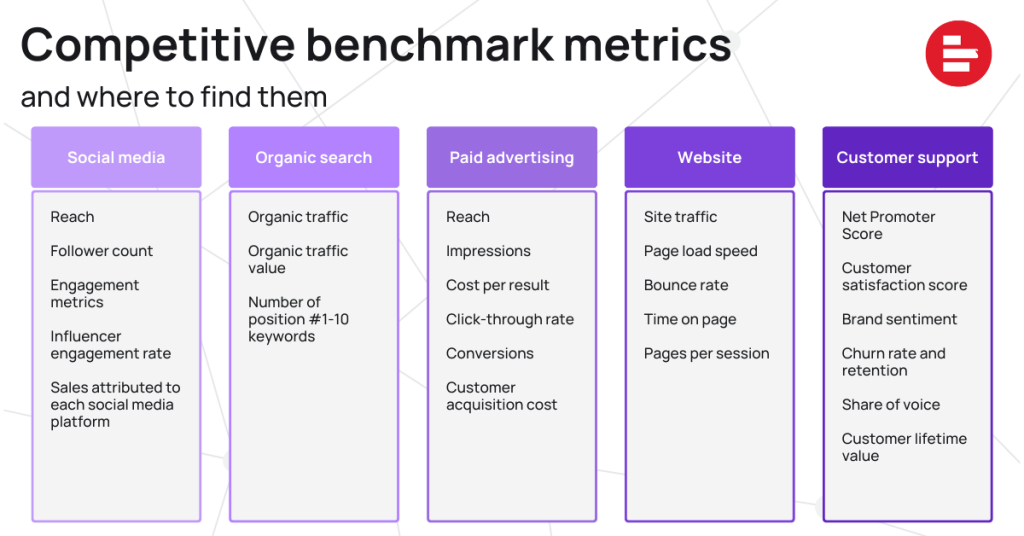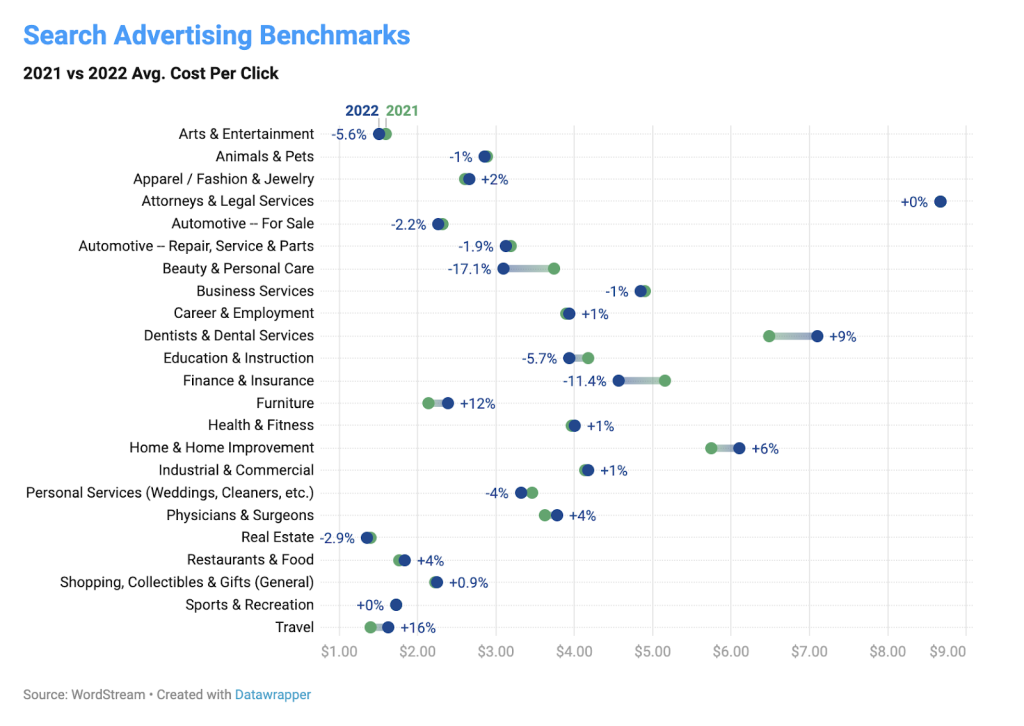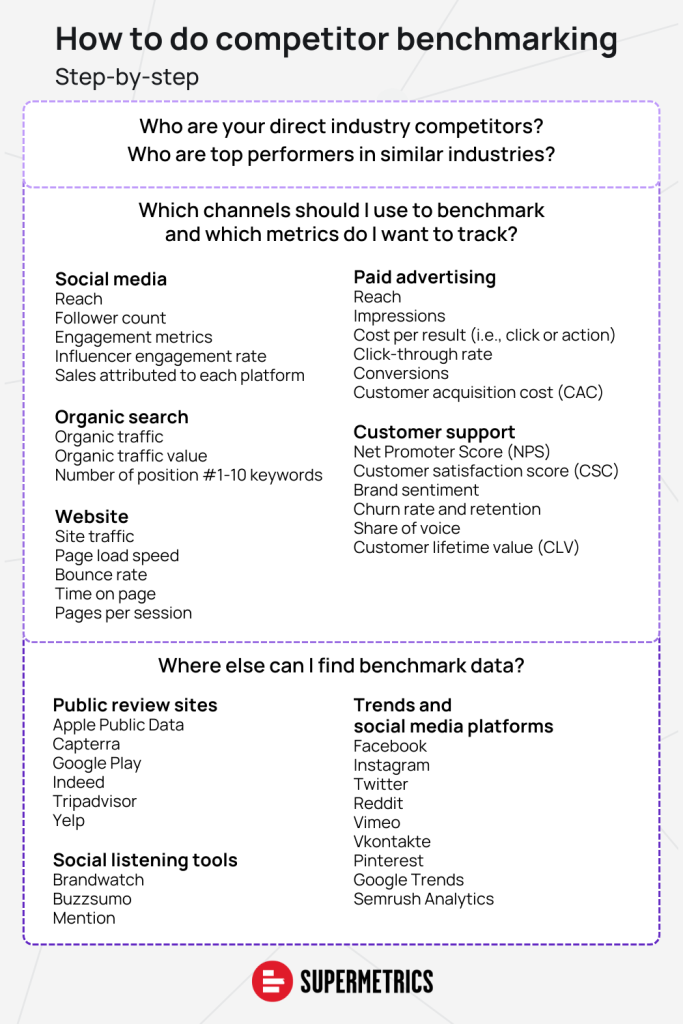Dec 9, 2022
How to do competitor benchmarking with public data sources
12-MINUTE READ | By Elise Dopson
[ Updated Oct 20, 2023 ]
Regardless of what your business sells, there’s always another brand offering comparable products or services.
That isn’t necessarily a bad thing. Competitors often execute marketing strategies that would work for your business, too. A competitive analysis uncovers those insights so you can replicate similar (or better) success.
Competitor benchmarking, however, is time-consuming. Businesses guard their most important metrics and key performance indicators (KPIs). By the time you’ve dug deep into their strategy, they’ve moved onto bigger and better campaigns.
Automate benchmarking with public data connectors. By sourcing already-available public data, you can save time and get insights faster.
This guide shares how to do competitive benchmarking—from the competitors you should compare against, to the public data sources that’ll help lift the hood on your competitor’s digital marketing strategy.
- What is competitor benchmarking?
- Why should you benchmark against competitors?
- How to choose competitors to benchmark against
- How to choose your competitive benchmarks
- How to measure competitor performance
What is competitor benchmarking?
Competitor benchmarking is the process of comparing your business’ most important metrics and KPIs against a competitors’. It’s a solid way of determining how you stack up.
Take competitor benchmarking for marketing campaigns, for example. If a comparable business’ strategy increases its Instagram follower count by 25% over a given period—compared to your 13%—it’s worth digging deeper into a competitor’s strategy. Evaluate what’s working for them, and consider replicating it for your own business to see whether you can achieve the same growth.
Why should you benchmark against competitors?
Regularly benchmarking against competitors allows you to conduct an accurate SWOT analysis for your marketing strategy. Find your strengths, weaknesses, opportunities, and threats to define strong brand messaging and value proposition.
Other benefits of competitive benchmarking include:
- Quickly reacting to market shifts and trends—like trending topics—before the wider industry picks them up, or peak season takes over
- Analyzing the results of your marketing strategy on brand awareness and market share
- Getting buy-in for future campaigns and budget increases by comparing raw data against your competitors, and accurately predicting the outcome of a similar strategy
- Turning marketing data into insights so you can finetune your strategy and set realistic goals for future campaigns
- Delivering better customer experiences—the defining factor in whether first-time customers will return in the future. It’s these loyal customers that account for 65% of a brand’s annual revenue.
Alex Chaidaroglou, Director and Co-founder of Altosight, adds that with competitive benchmarking, “You can learn which areas you can upgrade on when studying competitors.
Alex puts this into practice with a fictional business competitor that’s created a ranking list of the products it offers. “In response, you can optimize your website interface by creating a product comparison option that allows the customer to discern which is better by themselves.
“Aside from that, you can also include a ‘preferred by seller’ tag to guide your customers better,” Alex continues. “This will create a more convenient purchasing experience for website visitors and will no doubt improve your sales.”
How to choose competitors to benchmark against
The first step in benchmarking metrics against your competitors is to pinpoint the brands you’re competing with.
A direct competitor sells comparable products or services to your own. If you’re a B2B accounting software company, for example, competitors might be Xero, Freshbooks, or Quickbooks.
Get more granular with your competitor choice by narrowing your list down to businesses with similar traits to your own. If you’re a local company, for example, take Majesty Coffee’s approach and benchmark against nearby businesses. CEO and Founder, Nunzio Ross, says, “It provides us with opportunities to improve our business plan, and the local scene allows us to have closer, more accurate metrics to measure that would also work for us.”
Yoav Morder, Search and PR Director at Sonary, also has a set of criteria competitors must meet before benchmarking data: “We identify competitors to benchmark against the niche, size, region, and, most importantly, who pose a danger to our business in terms of competitiveness in the solutions offered.”
However, a competitor doesn’t just have to be another business selling the same product or service as your own. Deepanshu Bedi, Marketing Director at Holistapet, says, “When benchmarking for your startup, don’t limit yourself to your own industry. At its core, benchmarking is all about studying top performers in your own industry so you can get some best practices to use as a reference.
“But the point of benchmarking isn’t just to emulate. If you look at it like that, your benchmarking process would become more reactive instead of strategic” Deepanshu continues.
“Your goal should be to emulate where applicable, and dominate if possible,” Deepanshu says. “That’s why it’s very useful to look at other industries as well because a lot of business practices are industry-agnostic.”
How to choose your competitive benchmarks
Once you’ve determined the type of competitor you’ll benchmark against, choose the type of strategy you’ll compare—most often, the most important channel for your business. This determines the specific metrics and KPIs you’ll set as competitive benchmarks.
Let’s put that into practice with five of the most popular channels:

Social media benchmarks
Social media consistently drives results for brands. Some 90% of people buy from the brands they follow on social media. Spy on a competitor’s strategy with data visible on their public account.
When benchmarking, compare the following social media KPIs against your competitors:
- Reach
- Follower count
- Engagement metrics
- Influencer engagement rate
- Sales attributed to each social media platform
If you’re benchmarking influencer marketing campaigns, for example, calculate the percentage of people that viewed the post—i.e., their followers—by the number of likes on the post itself.
Content with a high engagement rate shows the collaboration got the attention of an influencer’s audience. Turn this marketing data into an insight you can act on. Find another influencer with similar traits—such as follower count, interest, and engagement rate on non-sponsored posts—to replicate similar success.
Organic search benchmarks
Half of people head to a search engine when starting their buying journey. The higher your website appears in these search results, the better. Backlinko found URLs in position one have a 27.6% click-through rate—compared to just 6.3% for those in position five.
Benchmark whether your marketing strategy is working with organic search metrics, such as:
- Organic traffic
- Organic traffic value
- Number of position #1-10 keywords
CMO Milo Cruz says that for FreelanceWritingJobs, “Some of the metrics we keep track of include website traffic volume, its sources, as well as the top-performing pages and content. This information allows us to see which marketing channels have the greatest potential for returns, and it also provides inspiration for our own content production process.”
Paid advertising benchmarks
Businesses invest in paid advertising to increase reach, awareness, and generate sales. But how do you know whether you’re paying over the odds for your advertising results?
Benchmark paid advertising metrics such as:
- Reach
- Impressions
- Cost per result (i.e., click or action)
- Click-through rate
- Conversions
- Customer acquisition cost (CAC)

Website performance benchmarks
You (or your competitor) can have the best digital marketing strategy in the world, but if your site traffic isn’t interacting with your website in the right way, money is being left on the table.
Analyze how website visitors engage with your site with performance analytics like:
- Site traffic
- Page load speed
- Bounce rate
- Time on page
- Pages per session
We can see this in action with the page load speed metric. Studies show that more than a two-second delay in page load times can force 47% of people to exit a website.
If the industry average is 2.5 seconds and your competitor’s site loads within 2.7, your page load speed of 2.3 seconds means you’re already ahead—even before you benchmark other off-site data points.
Customer support benchmarks
Brands with excellent customer support beat competitors that don’t. Positive customer support metrics influence consumer spend and retention—especially considering 61% of consumers have cut ties with a brand that delivered a negative customer experience.
If customer support is a priority of your business, benchmark the following customer experience metrics:
- Net Promoter Score (NPS)
- Customer satisfaction score (CSC)
- Brand sentiment
- Churn rate and retention
- Share of voice
- Customer lifetime value (CLV)
DoorLoop’s David Bitton puts this into practice: “Take the following scenario: You have issues with customer support performance but are still determining exactly why, where, or how to solve it.
“Competitor benchmarking will assist you in finding your individual pain point in that area, allowing you to discover the current industry best practices and apply the same techniques your competitors are doing to satisfy demands at the time,” David says.
“It helps in placing specific circumstances in their proper context, enabling you to learn about emerging business norms and assess whether your business is living up to standards set by its sector.”
How to measure competitor performance
Now you’ve shortlisted your competitors and identified the KPIs you’ll benchmark against, let’s take a look at how you can measure performance using public data sources.
Review sites
Customers share unbiased reviews—both positive and negative—of a competitor’s products and services. If customer support is the priority for your benchmarking, pull competitor reviews with Supermetrics connectors like:
- Apple Public Data
- Capterra Reviews
- Google Play Reviews
- Indeed Reviews
- Tripadvisor Reviews
- Yelp Reviews
Move marketing data from several of your competitors’ review platforms into one dashboard with Supermetrics. If you’re benchmarking app data, for example, use the Apple Public Data connector to pull a competitor’s star rating, review, and listing details into your own private dashboard—no copy and paste required.
Trends and social media platforms
Social media is one of the most important marketing channels for businesses. Studies show that 92% of brands are active on at least one social media platform.
The best part? Most social media data is publicly available, so you can eavesdrop on a competitor’s social media strategy using Supermetrics connectors. Automate data collection and pull KPIs from the most popular platforms in your industry, including:
If you’re comparing influencer marketing strategies amongst your competitors, for example, use the Facebook Public Data and Instagram Public Data connectors. You’ll pull real-time competitive benchmark metrics into your own personalized multi-channel reports, allowing you to keep track of both yours and a competitor’s influencer-related KPIs.
Social listening tools
Social media platforms offer data sets unique to that platform—often linked to a business’ account, branded hashtag, or influencer-endorsed post.
What about social media posts that discuss your competitors, but don’t tag their account? Go beyond surface-level data with social listening tools that uncover your competitors’ brand mentions.
Social listening tools also pickup mentions on websites that haven’t linked to a competitor’s site—and therefore, don’t appear in SEO software or backlink reports. Identify press releases, surveys, or case studies tied to your competitors.
Pro tip—Pay especially close attention to brand mentions flagged in a marketing agency or software company’s case study. These blog posts sometimes share guarded data, such as conversion rate increases, which you can use to benchmark performance metrics.
Popular social listening tools include:
Let’s put that into practice and say you’re benchmarking brand sentiment against other competitors. Your own data shows 60% of untagged brand mentions are positive. Competitor A is 78%; Competitor B averages 68%.
Dig deeper into these analytics and you see competitors get high praise for free one-day shipping guarantees. You currently offer free shipping on orders over $50—any orders below this threshold have a $3.99 delivery fee. Their item isn’t guaranteed to arrive the next working day, either.
Feedback to your ecommerce team and turn this data into an actionable insight. There might be a way to reduce operational costs and offer free one-day shipping to all orders, therefore increasing customer sentiment and claiming more market share.
Take the guesswork out of competitive analysis
The competitive benchmarking process doesn’t have to be complicated.
Start by uncovering your business’ goals and working backwards to identify the most important KPIs. Find competitors that share similar traits with your own business, and uncover your competitors’ guarded data with public data connectors—be that their social media profile, Yelp reviews, or brand mention in a press release.

About the author
Elise Dopson is a freelance writer for SaaS and ecommerce brands and the founder of Help a B2B Writer.
Turn your marketing data into opportunity
We streamline your marketing data so you can focus on the insights.